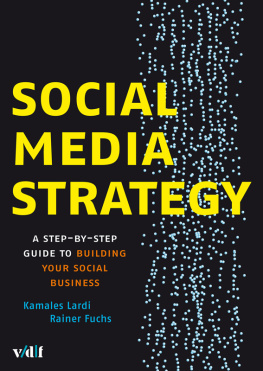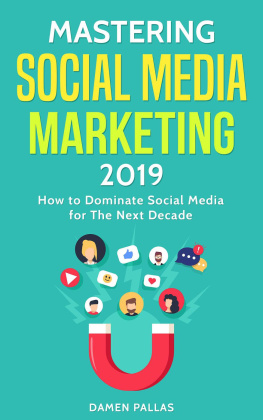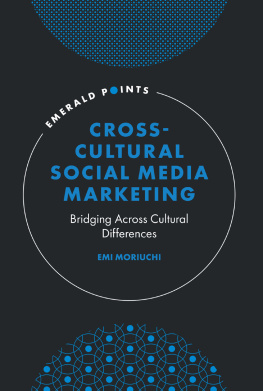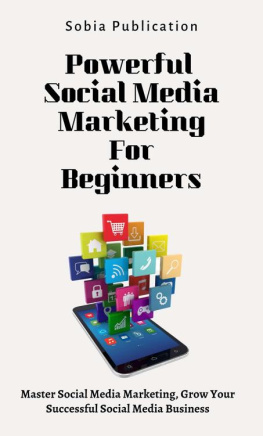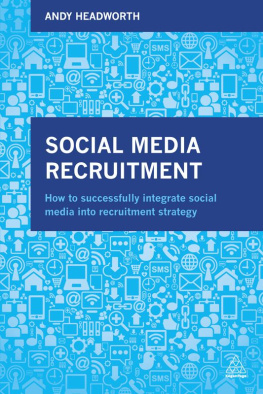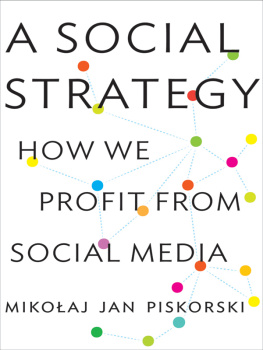SOCIAL MEDIA STRATEGY
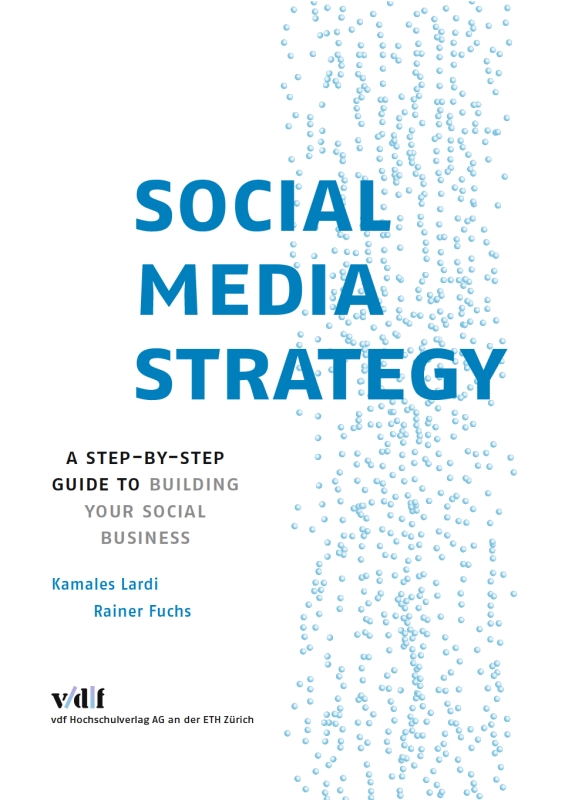

The ZHAW School of Management and Law is one of todays leading business schools in Switzerland, offering internationally recognized Bachelors and Masters degree programs, a broad range of continuing education courses and programs, and innovative research and development projects. The Institute of Marketing Management of the ZHAW School of Management and Law aims to connect scientific knowledge and practical application in the field of modern marketing.
www.imm.zhaw.ch
www.imm.zhaw.ch/blog

Lardi & Partner Consulting GmbH helps companies get clarity on their strategic goals and find ways to reach them. Combining professional expertise with proven methodologies, we develop strategies, define pragmatic and measurable solutions and support our clients in implementing them.
Visit us at www.lardipartner.com
Design book cover: Pauline Hoogweg, www.paulinehoogweg.com
Layout: Manuel Gchter, Oberegg/Zrich
Bibliographic Information published by Die Deutsche Nationalbibliothek
Die Deutsche Nationalbibliothek lists this publication in the Internet at http://dnb.d-nb.de.
All rights reserved. Nothing from this publication may be reproduced, stored in computerised systems or published in any form or in any manner, including electronic, mechanical, reprographic or photographic, without prior written permission from the publisher.
ISBN 978-3-7281-3557-5 Print
ISBN 978-3-7281-3578-0 eBook
Doi-Nr. 10.3218/3558-2
2013, vdf Hochschulverlag AG an der ETH Zrich
www.vdf.ethz.ch
eBook-Herstellung und Auslieferung:
Brockhaus Commission, Kornwestheim
www.brocom.de
| CONTENTS |
[SANDRO GRAF & TERESA VALERIE MANDL]
[KAMALES LARDI]
[KAMALES LARDI & ROLF RELLSTAB]
[KAMALES LARDI & ARMIN LEDERGERBER]
[RAINER FUCHS & HEIKE RAWITZER]
CHAPTER 1
A Sustainable Approach to Social Media for Businesses
[SANDRO GRAF & TERESA VALERIE MANDL]
Glancing at the agenda for the next executive board meeting, David Wallmer prepares himself for a challenging session. As the senior director of business development in a company with more than 10,000 employees in two continents, David is responsible for all initiatives labelled social media. He vividly remembers some of the boards previous discussions in the topic, which have sometimes been challenging. The lack of understanding of social medias business value and potential on the part of several executives, as well as his own inability to demonstrate returns on investment from the channels have left David frustrated.
The company David has been with for over ten years is very good at gauging the behaviour of its customers, and tailoring its products and services to their specific needs. After great effort, it has managed to position itself as a leading player and innovator in the highly competitive environment of consumer goods and today covers all major markets.
Davids department was quick to recognise the digital changes affecting society. They observed the emergence of social networks with interest and soon initiated their own concept. Well ahead of the competition, Davids team joined forces with the companys marketing and distribution teams in setting up a Facebook profile. While this initially focused on disseminating information to customers, interaction gradually increased. Today, the company offers customer support via Facebook. Many customer questions are answered directly by other customers, and support is provided by customer service staff only where it is necessary or requested.
Facebook was proceeded by Twitter, which was initially quite effective for one-way communication. The company mainly tweeted corporate news relating to new products or special achievements. While the Twitter feed was originally followed by journalists and existing loyal customers, the channel eventually became increasingly active and, after only a few months began to be used by potential new customers as well. Twitter followers started to use the account to respond to tweets and to make service enquiries.
As a result, the customer service department became quite busy with social media channel requests. Enquiries coming in via Twitter had to be addressed (and dealt with) immediately, in line with the dynamic nature of the medium and high customer expectations. This in turn led to higher staffing costs, particularly to cover weekend shifts. David has had several discussions with other departments regarding the impact of social media in the company. For example, the head of customer relationship management ( CRM ) argues that receiving requests and complaints on social media channels make it difficult to use standard CRM tools to manage and follow-up on enquiries as well as customer lead. This is because the platforms and customer data are not integrated.
As a consequence, it is becoming increasingly challenging to develop and maintain successful relationships with customers and other stakeholders. As social media became more popular throughout Europe, customers became more active in wanting to shape their experiences with the company and its products and services. They accessed their friends and peers online and interacted with them on different levels: by exchanging information and ideas, by providing peer support, leveraging their bargaining power and even engaging in co-creation. Eventually, the corporate communications department became involved and expressed the need for more proactive control of user-generated content on the social media channels used by the company.
Davids company also initiated important developments in HR management including convincing recruiters to utilise social media channels to search for high potential candidates. Early on, individual staff members started using Xing to establish and maintain business contacts. As the companys operations became more international, LinkedIn also gained importance. Today, the HR managers actively use these platforms in their international recruiting activities to advertise job vacancies and identify potential candidates. However, to date this has not led to a reduction in the use, and thus the costs of more traditional recruitment methods.
In recent months there has been an increase in evaluation of the company on platforms such as | www.kelzen.com |, which is used by former and current employees and job seekers to evaluate potential employers. Negative comments by individual former employees give external users a biased opinion of the day-to-day operations of the company. Management fears that this may result in a highly subjective (one-sided) company profile affecting public opinion and perhaps even influencing representatives of employers associations. So far, however, the companys efforts to address these risks have neither been effective nor coordinated.
Admittedly, David has profited from a very open and dynamic corporate culture that encourages a trial-and-error approach towards embracing new developments. On the other hand, pressure from senior management has increased to present financial figures justifying the investments made or proposed. At the beginning, external social media consultants promised great things and internal stakeholders placed high hopes on the use of social media tools for their business. Indeed, initially the company made remarkable progress in establishing direct access to its customers for the first time and took advantage of opportunities to learn about their likes, dislikes and desires. Customer interaction became more targeted and personal, leading to very valuable feedback. At the same time, in many ways the changes proved to be too radical for the company. While Davids fellow board members appreciate the great potential of social media, they are feeling uneasy about the risks and the uncertain outcome of social media measures with regard to the companys profitability.
Next page
